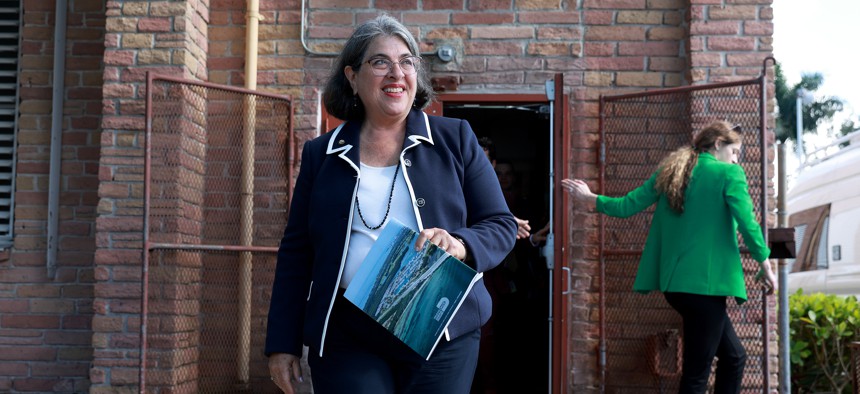Policy
Miami-Dade Mayor Levine Cava announces relief program to help working families pay rent
The county is now considered one of the most expensive areas in the United States to live.

In this file photo, Miami-Dade County Mayor Daniella Levine Cava leaves a meeting with U.S. Department of Housing and Urban Development Secretary Marcia Fudge where they discussed key resilience infrastructure projects, June 28, 2022 in Miami. Photo by Joe Raedle/Getty Images
A family of four earning close to $140,000 a year would be considered middle to upper middle class in much of the United States and many areas of Florida, including people who work as police officers, teachers, nurses, beginning attorneys and small business owners, or a young couple wanting to buy a home and have children.
Not so in South Florida, and especially Miami-Dade County.
It's almost impossible for middle class families to find a reasonably priced home, including rentals. The county is considered one of the most expensive areas in the United States to live. Many people are leaving because they simply cannot find a good place to live even if they work two or three jobs.
Now, Miami-Dade County Mayor Daniella Levine Cava has announced the expansion of the Emergency Rental Assistance Program (ERAP) with a goal to help more working families deal with rent increases and remain in their homes.
Related City & State stories
- Evictions, high rent: Renters in South Florida continue to struggle
- Bad reputation? Miami-Dade County's affordability problem continues to vex officials
During a recent news conference, Levine Cava said the ERAP has awarded more than $139 million since the program began at the beginning of the pandemic and has provided help to more than 21,200 families. Miami-Dade has allocated more than $8 million to the program.
“The price of housing has continued to skyrocket, and we want to be able to help more of our vulnerable residents,” Levine Cava said. She added that there are about 32,000 additional housing units in the pipeline, and this means there will be more housing opportunities for people. It's important to increase the area’s housing supply and this will increase competition so landlords will have to reduce their prices, she says.
Miami-Dade’s program is among the top 5 ERAPs in the nation and it provides help for up to three months. It's a component of the mayor’s HOMES Plan, approved in the 2022-23 annual budget as a part of a major investment of $500 million to tackle the affordability crisis and make it possible for working families to continue to live and work in Miami-Dade.
The Miami-Dade ERAP's expansion includes residents earning up to 140 percent of the area median income (AMI). A single person earning less than $95,620, couples making less than $109,200, families of three earning less than $122,920 and families of four earning less than $136,500 can qualify for rental assistance.
“For Miami-Dade to thrive, our residents must be able to afford to live here,” Levine Cava says. “Our county’s distribution of ERAP funds was so successful, we were able to apply for and receive more funds from the federal government to expand the program and help more renters. This new expansion will allow more financially struggling residents to tap into lifesaving funds to help them stay in their homes. That, in concert with our Building Blocks program and HOMES plan, will create a more affordable Miami-Dade for all.”
Michael Liu, director of Miami-Dade Public Housing and Community Development added, “We are building upon an already successful ERAP ... (and) by increasing the number of people that qualify for ERAP, more working professionals such as teachers, first responders, nurses and other essential workers can get assistance to cover rent costs in this difficult real estate market.”
ERAP can help renters with problems such as past due rent, utility payments, relocation assistance and rent increases up to 30 percent for a period of three months.
In April, the leadership of Miami-Dade County declared an affordability emergency as rents dramatically increased and many people could not afford to live in the county or the area. At the time, Levine Cava signed executive actions adding $13 million more to the ERAP program. Rents had increased more than 30 percent over the past year. The emergency rental assistance is money sent from the federal government to deal with the leftover problems related to the pandemic. Another goal was to streamline the permitting and building process for developers working to build affordable housing.
David Volz has been a reporter for numerous community news publications throughout South Florida over the past two decades, as well as the South Florida Sun-Sentinel, Miami Herald and South Florida Business Journal. He covers city government, schools, sports, culture, faith groups and workplaces.
NEXT STORY: Ten big issues in Florida insurance overhaul